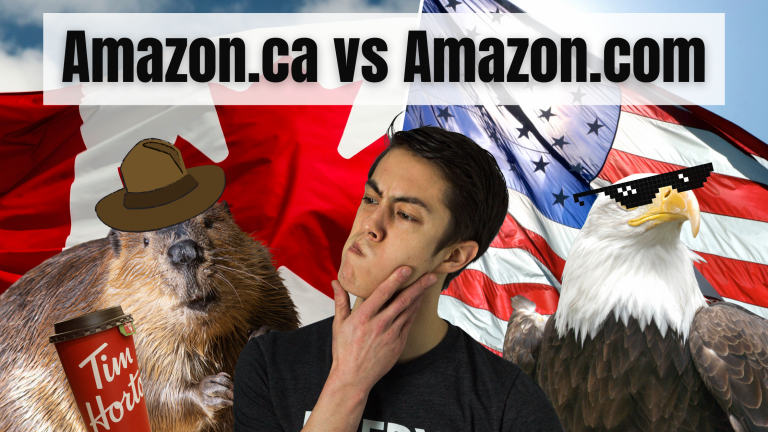If you sell on Amazon.com, chances are you’ve thought about expanding up north to Amazon.ca.
Fortunately, selling cross-border is remarkably easy because you can sell in the Canadian marketplace using the same Amazon Seller account.
With its relatively untapped market and booming ecommerce industry, expanding into the Canadian market might be just one of the best decisions you’ll ever make.
In this article, we’ll go over:
- The key differences between Amazon.com and Amazon.ca you need to know
- The main benefits of selling on Amazon.ca
- How to set up everything easy and fast so you can sell in Canada pronto
Let’s dive in.
Amazon.com vs Amazon.ca
I’m sure you already know that Amazon is an ecommerce behemoth with multiple different marketplaces around the world.
The great thing about scaling up your Amazon business internationally is that the Amazon platform basically works the same across every country it has a marketplace in.
However, every country is unique, so that means there will be differences between countries that will affect how you sell on their version of Amazon.
Let’s go over the main differences between selling on Amazon in the USA vs. Canada.
Size of the Market
Canada has a population of ~38.4 million people (as of 2021), whereas the USA has a population of ~331.4 million people. That’s almost 9x as much!
This can pose a challenge for Canadian sellers because, on average, you can expect to sell 10x less on Amazon.ca than Amazon.com. So if you sell 100 units per month in the US, you can expect to only sell 10 units per month in Canada.
Competition
The total number of products listed on Amazon.com is around 350 million, whereas there are only 133 million on Amazon.ca.
You don’t need me to tell you that with so many products on Amazon.com, competition is fierce. But based on these statistics, we can see that the competition in Canada is only ⅓ of what it is down south.
Pricing
When comparing the same or similar products, the average price (when USD is converted to CAD) for items sold on Amazon.ca is higher than on Amazon.com.
This can be explained by two reasons. The first is simple supply and demand. With less competition, products on Amazon.ca can be sold for a higher price.
The second reason—shipping—will be discussed below.
Shipping
Most freight forwarders charge a lot more to ship to Canada vs. the USA. This increased shipping cost will be reflected in higher prices.
Moreover, shipping products around Canada will be a lot more expensive than the US. Being a humongous country with a relatively small population, transportation costs are a lot more expensive and slower.
There are also far fewer shipping options than in the US. This means that if you plan on selling your products through Fulfillment by Merchant (FBM), you will need to factor this extra cost into your prices.
Which One Should I Start With?
Whether you’re a retailer or private label FBA seller, you might initially wonder which Amazon marketplace you should start with. The US or Canada?
I’d recommend everyone start with the US marketplace. There’s just so much demand and volume that it makes way more sense to start in the US and then expand to Canada later, compared to the other way around.
The Main Benefits of Selling on Amazon Canada
While selling on Amazon Canada does pose some challenges, there are some huge benefits to selling in up north that can’t be overlooked.
PPC Costs Lower
You’ll be happy to hear that PPC is, in general, more effective and less costly on Amazon.ca than on Amazon.com.
This is because the Canadian market is less saturated and less competitive, meaning there are fewer bidders raising up the price.
The downside is that yes, because the market is smaller, each keyword in Canada will only have a fraction of the search volume compared to its US counterpart.
You Can Charge More
You may have thought about simply converting your current prices in US dollars to Canadian dollars. But you can, and should, charge more in Canada.
While this is partly due to less product selection—and hence less competition (which drives prices up)—it is also largely because Canadian consumers expect GST (goods and services tax) to be included in the price.
Here’s a quick rundown of what you need to know about GST:
- GST is a Canadian sales tax.
- The GST rate is a flat 5%.
- Based on the declared value of the goods you imported, you owe the Canadian government a certain amount of taxes.
- You must also charge customers GST and pay it to the government, minus the amount you’ve already paid when your inventory was brought in.
Confused? Here’s a quick example to help make things clearer.
Let’s say you’ve imported $10,000CAD worth of inventory, and you’ve sold it all for $40,000CAD that same year. Here’s what you’d owe the Canadian Revenue Agency (CRA) at the end of the tax year:
(Note that this is a simplification of how it actually works. Please do not take this as tax advice. This is for educational purposes only.)
You Can Scale Very Fast
The takeaway from all these points is that you can generally scale up much faster on the Canadian Amazon compared to the US Amazon.
Your PPC Campaigns will be more effective and less costly, allowing you to sell more units at higher profit margins, which you can then reinvest into more marketing.
Of course, the main drawback is that your revenue potential is much lower than on Amazon US.
How to Sell on Amazon.ca: A Step-by-Step Guide
So you’re an Amazon FBA seller looking to expand to the US Amazon marketplace. What steps do you need to take to make the transition?
Let’s go over them below.
1. Choose Your Best Products to Sell on Amazon Canada
How do you know which of your products would sell best on Amazon.ca?
You could use product research software to analyze the market before diving in. But ultimately, you won’t know until you try.
I’d recommend for you to pick a few of your best sellers and then send a test batch into Amazon.ca and see how they perform.
2. Figure Out the Shipping Costs for Those Products
The biggest hassles for anyone expanding from Amazon.com to Amazon.ca are the higher shipping costs, additional work to sell on the site, and the difference in the exchange rate.
Typically, US sellers can increase their prices 35% to 40% to cover duties and shipping costs when selling in the Canadian Amazon marketplace.
Check out the difference in price between the same egg cooker sold in Canada vs the US:
The US one, when converted to CAD, would sell for $25.02CAD based on the current exchange rates. By contrast, the actual price on Amazon.ca is around $12.00CAD higher than that.
This is an extreme example of course, so you should not replicate this without doing your own research into the market. Try to find the sweet spot between price and demand.
3. FBA or FBM? Choose the Right Fulfillment Options
Price isn’t everything of course. There is another way to be more competitive in Canada and that is to choose a smart shipping option.
In almost every case we’d recommend FBA rather than FBM. Here’s why:
- Reliable & Scalable. Dealing with logistics in another country can be a pain, so it would be more time efficient to leave it to Amazon. Besides, Amazon is already known for their two-day shipping guarantee, which can be hard to surpass on your own.
- Reduces Customer Service Issues. You don’t have to worry about any customer service issues when it comes to shipping delays or damages.
- Makes You More Competitive. Any customer who sees that a product is eligible for Amazon Prime shipping will prefer it 9 times out of 10.
How to Set Up FBA for Amazon.ca
- Check that your products are not prohibited in Canada.
- Use the calculator to see how much FBA would cost for your products.
- Review shipping rates for FBA in Canada.
- Read the Canada Border Services Agency’s step-by-step guide to importing goods into Canada.
- Create listings on Amazon.ca.
- Send inventory to a fulfillment centre located somewhere in Canada.
There you have it!
4. Use NAUA to Manage Both Amazon Accounts
Trying to juggle two accounts can be tiresome, but thankfully Amazon has made it easier than ever to manage since they introduced North American Unified Accounts (NAUA).
Here’s what you need to know about NAUA:
- You can create and manage product offers in both the US and Canada.
- You can manage everything from a single Seller Central account interface.
- You don’t need to have a bank account in Canada. Simply use the Amazon Currency Converter for Sellers (ACCS) to receive payments in USD to your account.
- If you’re a Pro seller, you only pay subscription fees to one marketplace.
- You can create a combined Order Report detailing all North American sales.
5. Tailor Your Advertising Strategy for Amazon.ca
Copy and pasting your current strategy from the US to Canada isn’t the smartest way to go about it.
Here are some things you should consider when tailoring your strategy to Amazon.ca:
- Ensure your operations and budget are in good order so you can remain profitable. Make sure to factor in those Canadian tariffs which can lower profit margins. In general, aim for around 5-10% lower ACOS.
- Optimize your content listings to help boost conversions.
- Start with proven best sellers in the US marketplace to give you a higher likelihood that they will do well in Canada.
- Start out your manual PPC campaigns with your tried and tested keywords from your US campaigns, but also be sure to run an auto campaign in Canada. With auto campaigns, you can find new keywords that your customers are using more in Canada compared to the US.
- Always consider differences in spelling when creating your listings, infographics and campaigns.
Selling on Amazon Canada: Is It Worth the Effort?
All in all: is expanding your Amazon business into Canada worth the time and effort?
If you have the time and the budget, it’s a resounding yes!
Just make sure you have milked every opportunity you can get in the US first. The Canadian market can facilitate fast growth but with a lower cap on revenue potential.
Looking to expand? Check out Kenji ROI’s wide array of services to help ensure your listings are ready to perform in the Great White North.



